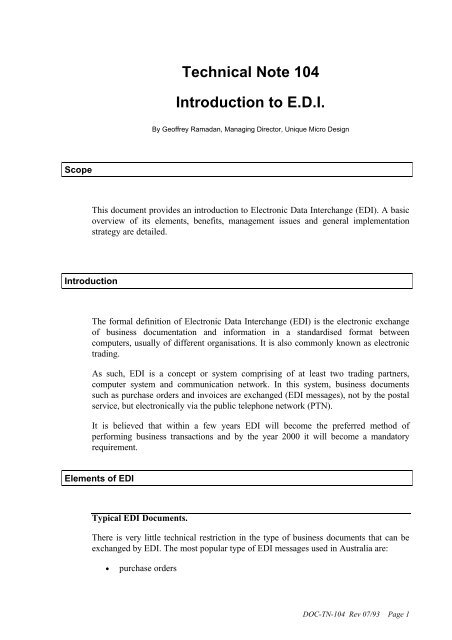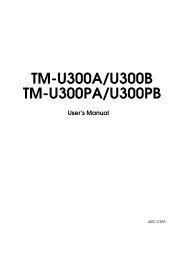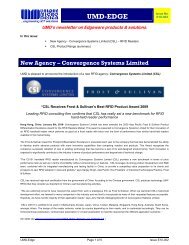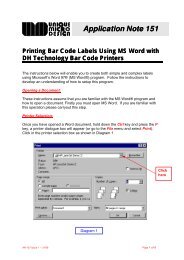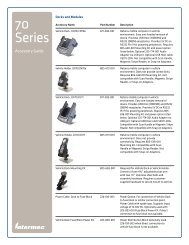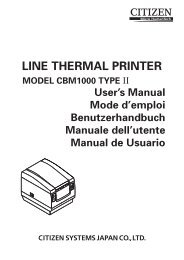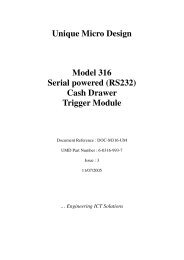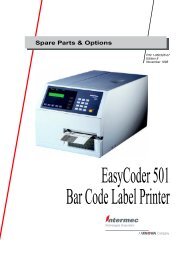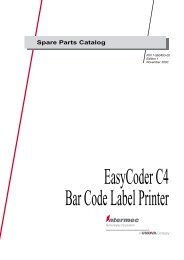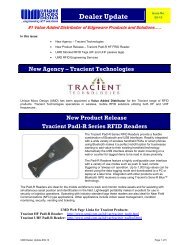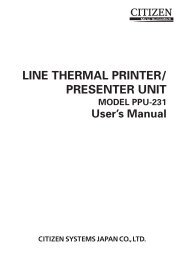Technical Note 104 Introduction to E.D.I. - Unique Micro Design
Technical Note 104 Introduction to E.D.I. - Unique Micro Design
Technical Note 104 Introduction to E.D.I. - Unique Micro Design
- No tags were found...
You also want an ePaper? Increase the reach of your titles
YUMPU automatically turns print PDFs into web optimized ePapers that Google loves.
<strong>Technical</strong> <strong>Note</strong> <strong>104</strong><strong>Introduction</strong> <strong>to</strong> E.D.I.By Geoffrey Ramadan, Managing Direc<strong>to</strong>r, <strong>Unique</strong> <strong>Micro</strong> <strong>Design</strong>ScopeThis document provides an introduction <strong>to</strong> Electronic Data Interchange (EDI). A basicoverview of its elements, benefits, management issues and general implementationstrategy are detailed.<strong>Introduction</strong>The formal definition of Electronic Data Interchange (EDI) is the electronic exchangeof business documentation and information in a standardised format betweencomputers, usually of different organisations. It is also commonly known as electronictrading.As such, EDI is a concept or system comprising of at least two trading partners,computer system and communication network. In this system, business documentssuch as purchase orders and invoices are exchanged (EDI messages), not by the postalservice, but electronically via the public telephone network (PTN).It is believed that within a few years EDI will become the preferred method ofperforming business transactions and by the year 2000 it will become a manda<strong>to</strong>ryrequirement.Elements of EDITypical EDI Documents.There is very little technical restriction in the type of business documents that can beexchanged by EDI. The most popular type of EDI messages used in Australia are:• purchase ordersDOC-TN-<strong>104</strong> Rev 07/93 Page 1
<strong>Unique</strong> <strong>Micro</strong> <strong>Design</strong> <strong>Technical</strong> <strong>Note</strong> <strong>104</strong>• invoicesOther EDI messages currently used in Australia are:• Advanced shipping notice - details of items <strong>to</strong> be despatched and when.• Contract award Order status report• Payment order - used <strong>to</strong> instruct the bank <strong>to</strong> pay supplier• Price sales catalogue - notice of new or changed prices• Product transfer and resale - forecast <strong>to</strong> enable manufacturers <strong>to</strong> planproduction schedules• Purchase order acknowledgment• Purchase order change - details of changes <strong>to</strong> purchase orders• Receipt of goods notice - details of damaged goods or discrepancies (underdevelopment)• Remittance advice - details of payment made <strong>to</strong> supplier• Report of test results• Request for quoteEDI StandardsAn essential element of EDI is that there be a standard format of data. The two mostcommon standards promoted in Australia are:• ANSI ASC X12 - USA ANSI Accredited Standards Committee X12• EDIFACT- Electronic Data Interchange for Administration, Commerce andTransportAs both standards are similar, there is cooperation between the two <strong>to</strong> facilitate theirconvergence. The EDI Council of Australia (EDICA) has set a directive for all EDImessages <strong>to</strong> adopted the EDIFACT standard by January 1994. However, in themeantime organisations may need <strong>to</strong> use both standards.DOC-TN-<strong>104</strong> Rev 07/93 Page 2
<strong>Unique</strong> <strong>Micro</strong> <strong>Design</strong> <strong>Technical</strong> <strong>Note</strong> <strong>104</strong>EDI SoftwareEDI software can be divided in<strong>to</strong> four components:Main Application:The organisation's inven<strong>to</strong>ry, purchasing and order processing programs. These may beexisting applications and may require some modification <strong>to</strong> maintain trading partnersreference files detailing EDI capability and audit trails of EDI messages.Application Interface:This interface provides the link between the main application program (iePurchasing/Order Entry Application) and the EDI software. It provides the necessaryinput/output translation in<strong>to</strong> standard EDI message formats from a flat file. Theapplication interface is specific <strong>to</strong> the organisation's main application and will need <strong>to</strong>be developedFlat FileFlat files contain EDI messages in standard formats and can be considered a commonfile between the Application and EDI software.EDI SoftwareThis program takes the standard EDI message in the flat file and performs the followingfunctions:• Translation (from flat file data format <strong>to</strong> EDI standard format)• Control & Auditing• Administration & Reporting• CommunicationsEDI MailboxThe EDI Mailbox is also commonly referred <strong>to</strong> as:• EDI clearing house• third party network• value added network (VAN)DOC-TN-<strong>104</strong> Rev 07/93 Page 3
<strong>Unique</strong> <strong>Micro</strong> <strong>Design</strong> <strong>Technical</strong> <strong>Note</strong> <strong>104</strong>• EDI networkIts main function is <strong>to</strong>:• provide temporary s<strong>to</strong>rage of EDI messages until they are collected by arecipient subscriber• provide a single reference point for operational difficulties with EDIcommunications• acts as a security wall or buffer between trading partners• provide independent message authentication, security and auditing• provide support for multiple trading partners with incompatible computersystems.Some EDI Mailboxes/networks in Australia:• Telecom Plus• General Electric Information Services (GEIS)• National Electronic Information Services (NEIS)• OTC Electronics Trading• Paxus ServicesBenefits of EDIEDI is not about information technology, it is about business and the benefits it canbring <strong>to</strong> a business. Many of the problems associated with paper based informationsystems can be resolved using EDI. Just some of these benefits are summarised below:• reduced order transit time delays• reduced labour cost associated with re-keying data• reduced or eliminate data errors• improved cus<strong>to</strong>mer service• reduced inefficiencies associated with paper handing (filing, copying archiving)DOC-TN-<strong>104</strong> Rev 07/93 Page 4
<strong>Unique</strong> <strong>Micro</strong> <strong>Design</strong> <strong>Technical</strong> <strong>Note</strong> <strong>104</strong>• reduced working capital and inven<strong>to</strong>ry• improved trading relationships• faster response time from suppliers• reduced recurrent expenditure• improved organisational effectiveness• reduced supplier cost through improved tendering processManagement IssuesWhile EDI does involve technical issues, the major considerations are strategic businessissues that arise from the adoption of EDI technologies and practices. To implementEDI both a structural change is required and the organisation's business plan needs <strong>to</strong>be re-visited.The three major considerations are:• Strategic implications of EDI (why get in<strong>to</strong> EDI)• Implementation strategy (how one resolves the structural change inimplementing EDI)• Competitive advantage (how one can take some competitive advantage inimplementing EDI)Strategic Implications of EDI• Cus<strong>to</strong>mers demand EDI as a requirement of trading with a supplier• Cus<strong>to</strong>mers demand data quality and timeliness as well as product quality andtimeliness• Wish <strong>to</strong> exploit EDI opportunities with suppliers and other trading partners• Internal adoption of EDI <strong>to</strong> take advantage of improved business practises• To become a market leader and innova<strong>to</strong>r with cus<strong>to</strong>mers• To establish a true partnership with your trading partnersDOC-TN-<strong>104</strong> Rev 07/93 Page 5
<strong>Unique</strong> <strong>Micro</strong> <strong>Design</strong> <strong>Technical</strong> <strong>Note</strong> <strong>104</strong>Implementation strategyBusiness function:EDI should bring about an innovative change <strong>to</strong> the business process as managers andstaff understand that data and information are no longer constrained <strong>to</strong> paperdocuments. Thus the function of management and staff will also change as a result ofthe changing role and structure of the department or organisation.Human resource issues:EDI will have a major impact on personnel. This impact should be positive as EDIshould enrich the function of management and staff in the purchasing and or sales orderprocesses. It will provide an opportunity <strong>to</strong>:• eliminate mundane tasks such as re-keying, error checking and filing• manage by exception (eg au<strong>to</strong>matic reporting by irregular transactions)• improve cus<strong>to</strong>mer/supplier service• increase and/or improve research and analysis through au<strong>to</strong>matic databasemaintenance• review job function and redefine roles <strong>to</strong> better utilise human skillsThough personnel changes are positive, management should be aware and moni<strong>to</strong>r staffattitudes.Organisational RelationshipsThe other trading partner relationship will need <strong>to</strong> be considered as an effectivecommunication with trading partners will be important. Experience has shown that anatural outcome of implementing EDI has been the development of closer workingrelationships between trading partners.Other issues <strong>to</strong> consider include:• Legal implications• Ability for organisations <strong>to</strong> work <strong>to</strong>gether• Responsiveness of organisations• Need for frequent contact <strong>to</strong> resolve issues• Amount of information <strong>to</strong> be sharedDOC-TN-<strong>104</strong> Rev 07/93 Page 6
<strong>Unique</strong> <strong>Micro</strong> <strong>Design</strong> <strong>Technical</strong> <strong>Note</strong> <strong>104</strong>Distribution:The gains achieved through EDI tend <strong>to</strong> lead <strong>to</strong> Just In Time (JIT) approach <strong>to</strong>inven<strong>to</strong>ry management. This may impact on existing practices and procedures (egincrease in the number of small deliveries received or despatched, reduced warehousingspace).Financial Administration:Accounting and financial functions and processes will need <strong>to</strong> be developed <strong>to</strong>accommodate EDI transactions. New processes and procures will need <strong>to</strong> bedeveloped for the following:• accounts payable/receivable problems• updating of ledgers and when this is <strong>to</strong> occur?• exception reporting procedures• moni<strong>to</strong>ring systems (such as executive information systems)Audit Issues:As EDI is based on different concepts and procedures <strong>to</strong> traditional paper basedsystems, audit procedures will need <strong>to</strong> be re-vamped. As information is now s<strong>to</strong>red incomputer based form thorough audits can be performed and on a more regular basis.This also leads <strong>to</strong> easier internal and external audits.Legal Issues:Signatures in existing paper based system are used <strong>to</strong> identify responsibilities andprovide authorisation. There is no special legal framework for EDI system, thus theburden of proof remains unchanged. A major legal concern with EDI is on ofidentifying a cost effective means of keeping commercial exposure <strong>to</strong> a minimum.Systems and procedures must be developed <strong>to</strong> meet these requirements. To overcomesome of these issues EDI trading agreements should be drafted.EDI Trading AgreementsEDI trading agreements do not set out what business is <strong>to</strong> be transacted betweentrading partners, but how they will be transacted. Typically EDI trading agreementswill contain:• Key definitions• Standards <strong>to</strong> be used• Signatures• Receipt of transmissionDOC-TN-<strong>104</strong> Rev 07/93 Page 7
<strong>Unique</strong> <strong>Micro</strong> <strong>Design</strong> <strong>Technical</strong> <strong>Note</strong> <strong>104</strong>• Third party service providers• Systems operations• Security procedures• Records and audit procedures• Liability and insurance• Confidentiality• Applicable law and dispute resolution procedures• General terms and conditionsCompetitive advantagesMany organisations view EDI as a strategic business opportunity that is fundamental <strong>to</strong>an organisation as the adoption of <strong>to</strong>tal quality management principles. Some even viewEDI as being essential for business survival, as the adoption of electronic tradingmethods is fast becoming a business imperative for all organisations that wish <strong>to</strong> remainviable. However, EDI is a <strong>to</strong>ol, and as a <strong>to</strong>ol it should be used <strong>to</strong> meet businessobjectivesMarketing strategy:How will EDI benefit you organisation and what marketing gains can be made (cheaperproducts, quicker delivery, better cus<strong>to</strong>mer service etc)? Some other aspects <strong>to</strong>consider are:• impact of providing cus<strong>to</strong>mers with on-line catalogue service• processes <strong>to</strong> ensure cus<strong>to</strong>mer feedback• processes <strong>to</strong> ensure marketing intelligence is still maintainedManufacturing strategy:With improved data, better inven<strong>to</strong>ry control and quicker supplier responses, EDI tends<strong>to</strong> lead <strong>to</strong> Just In Time practices.Financial Strategy:With increased gains in cash flow (through quicker processing of orders) andadministration cost saving associated with EDI do these gains go <strong>to</strong> reduced pricing,increased profits, increase in marketing or other budgets etc?DOC-TN-<strong>104</strong> Rev 07/93 Page 8
<strong>Unique</strong> <strong>Micro</strong> <strong>Design</strong> <strong>Technical</strong> <strong>Note</strong> <strong>104</strong>Implementing EDIThe implementation of EDI needs a clear commitment from senior management as itinvolves a structural change.BHP for example identified the following critical success fac<strong>to</strong>r in implementing EDIon time:• Don't take anything for granted• Set realistic objectives• Educate your organisation• Choose the right people• Involve trading partners from the start• ensure your network provider really understands your needs• Be prepared <strong>to</strong> change and manage that changeExecutive Action Plan• Ensure EDI implementation is consistent with the long term organisationstrategic direction• Participate or establish EDI industry working group• Ensure legal agreements are in place prior <strong>to</strong> trading (EDI Trading agreement)• Review risks associated with each transaction type and how they are <strong>to</strong> beaddressed• Establish adequate internal and external audit systems <strong>to</strong> satisfy legal andmanagement requirements• Ensure sufficient time <strong>to</strong> test, analyse and enhance application software• Ensure appropriate security measures are established including data securitypolicy and formal data communication policy• Ensure appropriate level of security for the transaction type being processedDOC-TN-<strong>104</strong> Rev 07/93 Page 9
<strong>Unique</strong> <strong>Micro</strong> <strong>Design</strong> <strong>Technical</strong> <strong>Note</strong> <strong>104</strong>• Ensure procedures are updated and reviewed and staff trained prior <strong>to</strong>implementationReferencesEDI a Better Way, Commonwealth of Australia, Published by Standards AustraliaEssential of EDI Law (Australian Edition), Peter Jones & Diana Sharpe, EDI Councilof Canada, 1993EDI Control & Audit Issues for Managers, Users and Audi<strong>to</strong>rs, William J Powers,Coopers & Lybrand, 1989EDI for Managers & Audi<strong>to</strong>rs, Sally Chan, EDI Council of Canada, 1992EDI Control Guide, EDI Council of AustraliaEDI Message Security Guide, EDI Council of AustraliaModel EDI Trading Agreement, EDI Council of AustraliaThe Electronic Trading Direc<strong>to</strong>ry: Australia, Technosocial Research Services, P.O.Box 21 Brunswick VIC 3056, Tel: (03) 419-3992Trading with EDI The Legal Issues, Hans Thomsen & Bernard Wheble, IBC FinancialBooks, 1989SubscriptionsAustralian EDI Report, 10 issues per year published by Technosocial ResearchServices, GPO box 1240L, Melbourne 3001, Tel: (03) 602-1544 Fax: (03) 602-3216Solutions, Telecom Plus quarterly newsletter, Reply paid No. 479, Telecom Plus, 1/157Walker St, North Sydney NSW 2060EDI Forum, (The Journal of EDI (Canada)), Published by EDI Group Ltd &distributed in Australia by Beechdale ConsultingEDI World, 2021 Coolige St, Hollywood, FL 33020-2012, USAElectronic Trading, (The European EDI magazine), Blenheim House, 630 ChiswickHigh Road, London W4 5BG, Great BritainDOC-TN-<strong>104</strong> Rev 07/93 Page 10
<strong>Unique</strong> <strong>Micro</strong> <strong>Design</strong> <strong>Technical</strong> <strong>Note</strong> <strong>104</strong>ContactsEDICA, The EDI Council of Australia, 2nd Floor, 854 Glenferrie Rd, Hawthorn VIC3122, Tel: (03) 819-6860 Fax: (03) 818-3129Ferntree Computer Corporation, 310 Ferntree Gully Road, Clay<strong>to</strong>n VIC 3168, Tel(03) 541-5600 Fax: (03) 543-3671. Major service provider and consultant of EDI bothlocally and internationally. They have a strategic alliance with Telecom.Standards Australia, 19-25 Raglan St, South Melbourne 3205. Tel (03) 693-3555Fax (03) 696-1319.Technosocial Research Services, P.O. Box 21 Brunswick VIC 3056, Tel: (03) 419-3992. Major source of EDI information, reports and consulting services .Telecom Australia (Tradelink & Telecom Plus). 1/181-189 Vic<strong>to</strong>ria Parade,Collingwood VIC, Tel (03) 412-1600 Fax: (03) 412-1000 Free call 008-807-324Wise Corporation, Level 21, 114 William St, Melbourne VIC 3000, Tel: 03-600-4488Fax: (03) 600-4867. Change management, <strong>to</strong>tal quality management and technicaldocumentation specialist.<strong>Unique</strong> <strong>Micro</strong> <strong>Design</strong> Pty Ltd(A.C.N. 007-419-490)Unit 2/23 Wadhurst DriveBoronia VIC 3155 AustraliaTel 03-887-1022 Fax 03-887-0734(c) Copyright 1993DOC-TN-<strong>104</strong> Rev 07/93 Page 11


